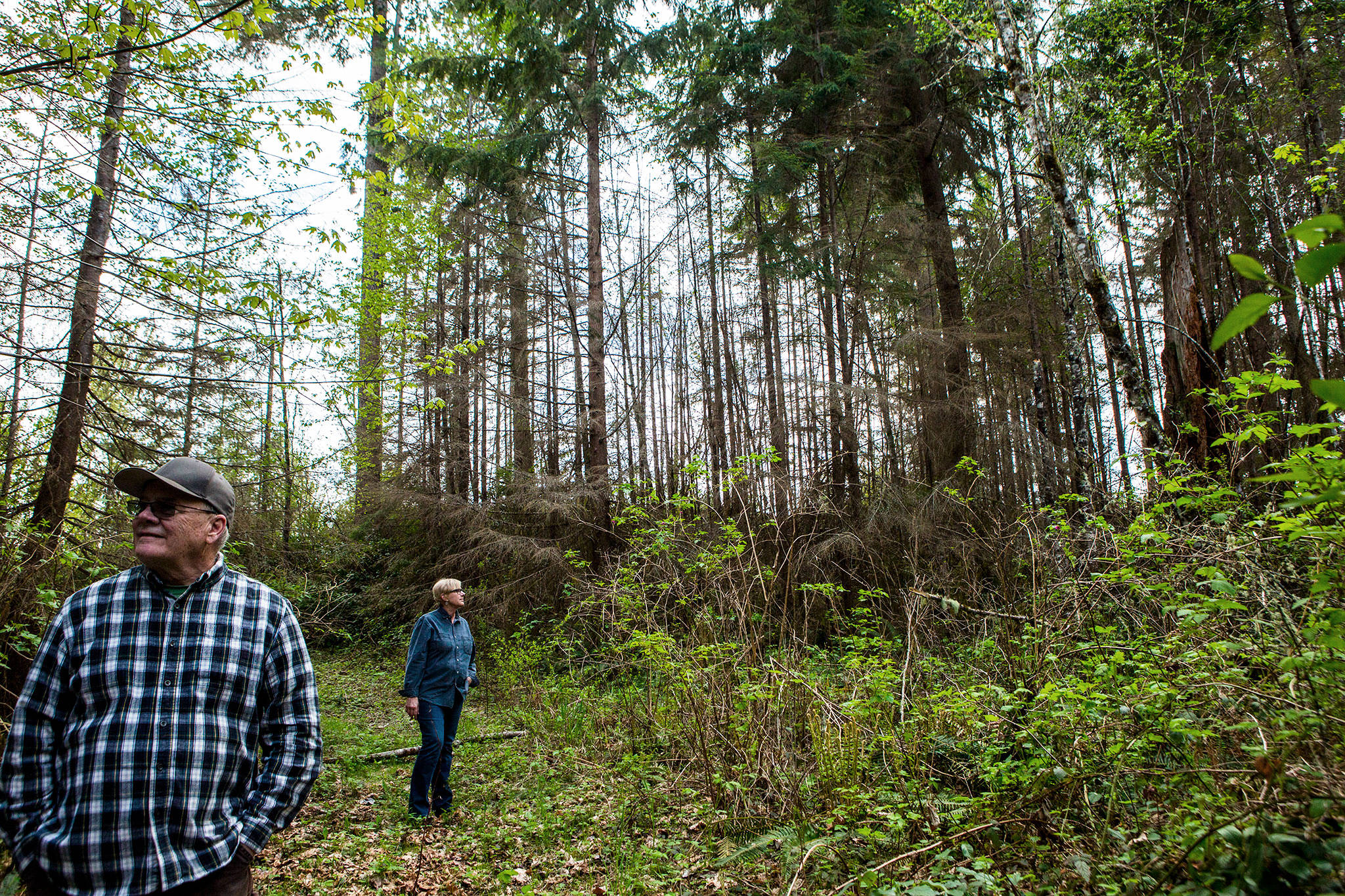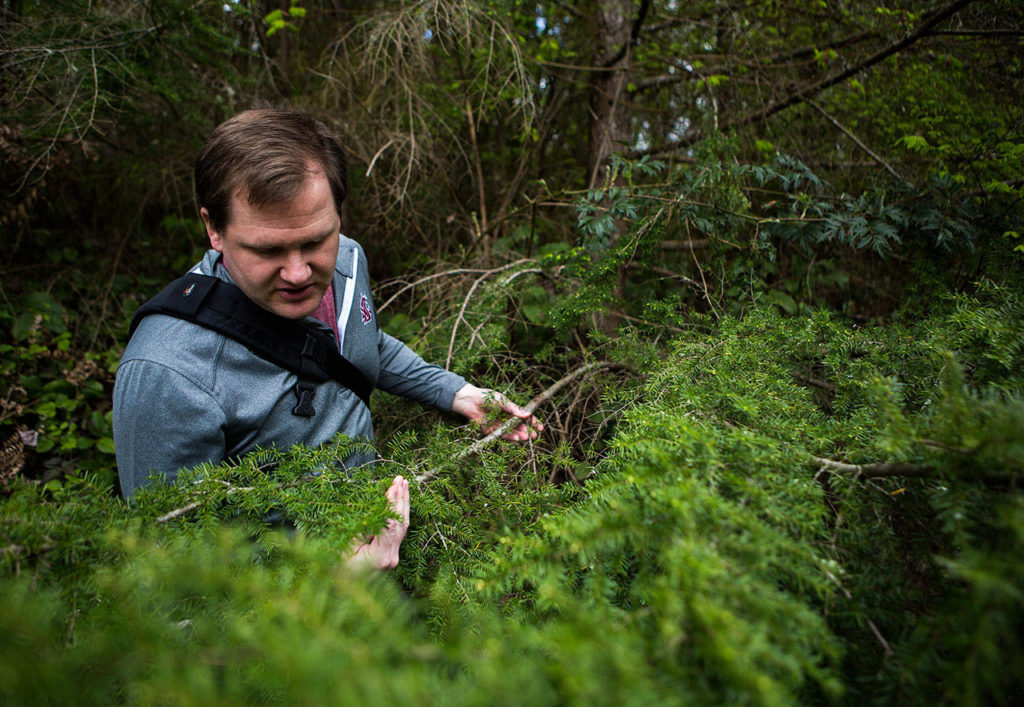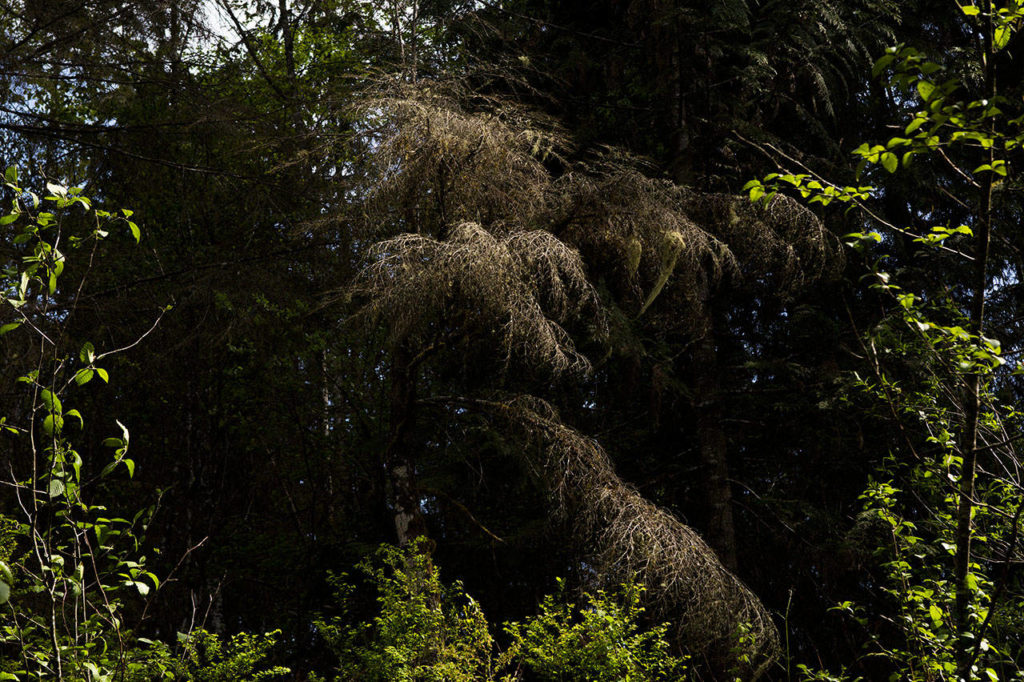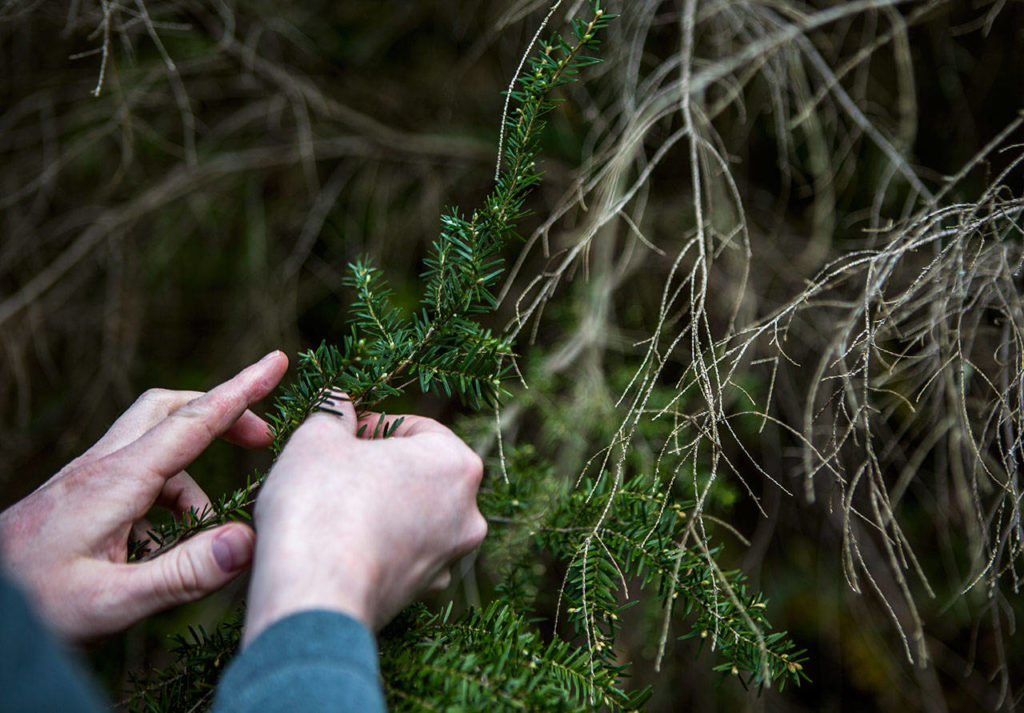GRANITE FALLS — There’s a killer out there.
It’s stalking forests, searching for its preferred prey: western hemlocks.
When it strikes, as it has with increasing frequency, the tree’s demise can be swift. The needles typically die off in a certain sequence.
Jim and Judy Davis have seen the blight hit the 25 acres of forest they own in the Granite Falls area. Jim, a semi-retired executive coach, and Judy, a sculptor, have witnessed big changes since they moved there about two and a half years ago.
“At first, it was like, ‘Oh, this branch is dead.’ Then it was ‘That branch is dead,’” Judy Davis said. “It was like a stepladder going up the tree.”
“In a year and a half — bam!” Jim Davis said.
She describes a ghost-like stand of hemlocks “that looks like something out of ‘The Walking Dead.’ ”
Tree experts have been watching similarly scary scenes throughout Western Washington and Oregon. In the wild, the most-affected species is western hemlock, while at Christmas tree farms, it’s showing up in other kinds of trees.
Kevin Zobrist, an associate forestry professor with Washington State University Extension, has been finding it wherever he’s traveled in Western Washington.
“That’s totally consistent,” Zobrist said while visiting the Davises last month. “The same stuff I saw on their property is what I’m seeing everywhere. My perception is that in the wild it’s spreading at an exponential rate.”
Lab tests suggest the likely culprit is a type of fungi known as rhizoctonia, and that drought also plays a role. There’s still a lot they don’t know. The hemlock problems aren’t believed to have a direct connection to a decline in big leaf maples throughout the region, though higher summer temperatures and drought could be affecting both species.
Area Christmas tree farms suffered major setbacks after record-breaking heat and dryness during the summer of 2017.
The western hemlock, Washington’s state tree, can grow to more than 200 feet tall. It’s found at sea level and high elevations from northern California well into Alaska.
Zobrist’s first encounter with a hemlock afflicted by a possible case of rhizoctonia happened on Whidbey Island in 2016.
“I talked to a lot of people,” he said. “We thought it was probably related to a drought we were having that year.”
Problems have continued to show up since then. And these trees don’t fit the normal drought pattern.
In extremely dry conditions, trees typically die from the top down, as the water column inside the tree stem breaks and higher-up sections of the tree no longer receive water, Zobrist said. With the hemlocks, the pattern of dead needles was progressing in the opposite direction, from the bottom up.
“I don’t think we’re going to see a wholesale die-off,” he said. “Where we see the mortality is on sites that are marginal for the species. When you add climate change to that, the trees may find themselves just on the other side of what might be an acceptable site.”
His colleagues still don’t understand why some trees succumb to the condition and others don’t.
“There’s not a rhyme or reason that we’ve figured out yet,” Zobrist said. “It’s not every hemlock. It seems to be a group of hemlocks here, a group of hemlocks there. Or even just scattered individuals.”
There’s no obvious signs of the fungus on dead needles. Zobrist needs help from a lab. He sends samples of diseased trees to the WSU Puyallup diagnostic clinic.
Zobrist is hardly alone in noticing the problems. Scientists at Oregon State University have been investigating as well.
Dan Omdal, a forest pathologist at Washington’s Department of Natural Resources, has been seeing the same thing.
“It’s a relatively new phenomenon with the rhizoctonia,” Omdal said. “We only isolated that pathogen in 2015.”
Being relatively shallow-rooted, western hemlocks may be extra susceptible to a lack of water.
“When the soil dries out in the summertime, it’s one of the first species to experience the effects of drought,” Omdal said.
The tree pathologist considers rhizoctonia an “opportunistic pathogen” — one that normally wouldn’t pose a problem, but becomes deadly to trees under the right conditions.
“It was almost a perfect storm with the drought and the high temperatures,” he said. “It put these hemlock trees in a state where they would be vulnerable to a heretofore innocuous fungus.” The condition is sometimes called “web blight.”
“In contrast to other foliage diseases, where infected needles are ‘cast’ or dropped from the branch, needles infected with web blight remain attached to the branch, often in clumps held in place by what looks like spider webs, which are the fine mycelia threads of the fungus, hence the name ‘web blight,’ ” Omdal explained, in an email.
A change in the weather could still turn things around.
“There’s a good chance we may not hear from this pathogen again if we have a cool, moist summer,” he said.
They’re only beginning to wrap their minds around the extent of the problem. Omdal called it “the look-see stage.”
WSU Extension’s Zobrist said there’s no reason to panic. In the short term, he’s giving generic advice to landowners.
“My biggest take-home message is that if you have trees that are dying, especially hemlocks and cedars, which have the lowest drought tolerance, don’t replace them with hemlocks and cedars,” he said. “Replace them with something that’s more drought tolerant.”
Douglas firs and grand firs do a little better. But if those species are struggling, he recommended pine, madrone or oak, which are even more drought tolerant.
Thinning can help, too.
“The other message is that people need to be reducing density in dense areas,” he said. “The cup of water is getting smaller and the more straws that are in that water the more thirsty everyone is going to get.”
In some cases, Zobrist said people are doing things that make no sense, like spraying pesticides that won’t solve fungal or drought issues.
“People are doing things like going out and spraying for things that aren’t there,” he said. “It’s not something where pesticides would even be appropriate.”
The forester’s advice has taken root with the Davises.
The couple is proud of what they’ve accomplished during their relatively short time near Granite Falls. Jim Davis grew up in Ohio, and later moved to Arizona, California and southwest Washington.
“I’ve never lived in a place where plants grow like they grow here,” he said.
A WSU Extension forest stewardship class last fall helped open their eyes, especially when it comes to knowing what to look for in a diseased forest.
“We’d been more gardeners than foresters,” Jim Davis said. “… Gardening is putting the human imprint on the environment. Forestry is more understanding that the forest has its own life cycle. You’re there to support it in its life cycle.”
That’s something they’re trying to do now, to cope with the unhealthy hemlocks. Some trees that were only partially dead a month ago are completely dead now, Jim Davis said.
“We’re deciding how to tackle it,” he said. “We want to clear a lot of these dead trees out to lessen fire danger.”
That follows a suggestion from Zobrist.
The couple is determined to keep at it. They’d like to pass down the land to future generations of their family.
“As we become good stewards, maybe others will do the same,” Jim Davis said. “You see it from season to season. It doesn’t take a long time for the environment to respond to a little change. It’s also good for us. It feeds the soul. We live in a very chaotic world. It changes your relationship not just with the land, but also with other people. It changes the attitude, it slows you down. It’s a very powerful impact on how we see the world.”
Noah Haglund: 425-339-3465; nhaglund@heraldnet.com. Twitter: @NWhaglund.
Talk to us
> Give us your news tips.
> Send us a letter to the editor.
> More Herald contact information.




























